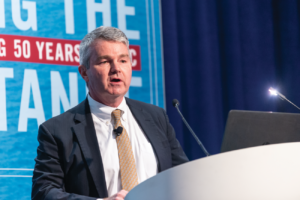Tangible results show big data is already transforming today’s oilfield
Examples from offshore, unconventionals and process automation demonstrate power of using data-driven decision to drive improvements
By Linda Hsieh, Editor & Publisher, and Sarah Junek, Associate Editor
When Gordon Moore, co-founder of Intel, predicted in 1965 that the number of transistors on a computer chip would double every two years, the oil and gas industry probably didn’t give much thought at the time to how computing capabilities would impact drilling a half-century later.
Now, with approximately 20 billion transistors on a chip and the ability to store, aggregate and transmit vast amounts of data cost effectively using the internet, this digital ecosystem is rapidly making wellbore construction safer, more efficient and less environmentally impactful, said Clay Williams, National Oilwell Varco (NOV) Chairman, President and CEO, at a 2019 OTC panel discussion on how big data is transforming the oil and gas industry. He discussed three technologies that illustrate how this shift is already happening in the field. “It’s not some sort of technological utopia that we’re hurtling toward; it’s in use today,” he said.

One example of what the digital revolution can do can be seen in the unconventionals, where stuck pipe can sometimes result when using coiled tubing to drill out frac plugs after stimulation. “When it happens, it’s actually pretty expensive,” Mr Williams said. “One of our customers shared that, when drillout proceeds as planned, it’s about a $250,000-line item, but when pipe gets stuck, it can average around $1.7 million.” That kind of expense can significantly erode the profitability of the well.
So when an operator approached NOV to install sensors in coiled-tubing operations and transmit data back to the office for analytics, the two companies began to collaborate on data collection in millout operations. “They were able to identify warning signs before the pipe got stuck and developed an operating procedure called stop, drop and circulate. When they saw those warning signs, they would change their procedures out in the field,” Mr Williams said.
Since this procedure was put in place a couple of years ago, the number of stuck pipe incidents for this operator has fallen to zero. “You always make better decisions when they are data based.”
Another example of the impact of digitalization can be found in the continued up-ending of the traditional calendar-based maintenance approach that has been practiced on rigs for decades. Over the past few years, NOV has been working with several offshore drilling contractors to leverage data collected directly from rig equipment and “put in place smarter ways to manage maintenance routines,” Mr Williams said. He pointed to the work NOV did with one contractor on a regulator valve in 2016, where analysis of 6 billion data points enabled the prediction of the valve’s failure – two weeks before it happened. “We’re really making great strides in improving maintenance and improving the reliability of complex drilling systems around the world.”
Lastly, Mr Williams talks about NOVOS, an open software system that NOV has installed on rigs to eliminate the need for drillers to manually execute each step in the drilling process. “We’ve done a great job replacing old rigs and upgrading the capability of drilling rigs, both land and offshore, and we moved from brake-handle drilling to joystick drilling,” he said. Yet, even with joysticks, drillers today still must focus on each tedious step of the process. “They can do it with much better equipment, and it lasts longer. It gives them a lot more data coming back, but they’re still rig drivers.”
Further, “the velocity of the machine he is driving is accelerating rapidly,” Mr Williams continued. In the early 1980s, the average daily footage per rig was about 250 ft. “That has tripled since then… We have put more and more on the shoulders of our drillers.”
Take, for example, the process of tagging bottom, which involves 13 discrete steps. By using software to automate all 13 steps, not only is the driller freed up to focus on their crew and on safety, but it ensures that all of those steps are done the same way every time. Automating the process further eliminates human errors, such as undertaking the process too quickly so that when the bit hits the bottom of the hole, it sends a small shock wave up through the BHA; this can lead to premature failure of the electronics and MWD. “It’s sort of a Goldilocks way to engage the bottom of the hole. You can program that in and have the computer do it precisely every time in a much more consistent way.”
NOVOS is operating on approximately 60 rigs around the world. Its open software architecture means that most of its current 32 apps were not developed by NOV but by oil companies and service companies, and even individuals and consultants who focus on a particular aspect of drilling. “You can get a software developer kit from us and write your own app to make your operations more efficient,” Mr Williams said. DC






